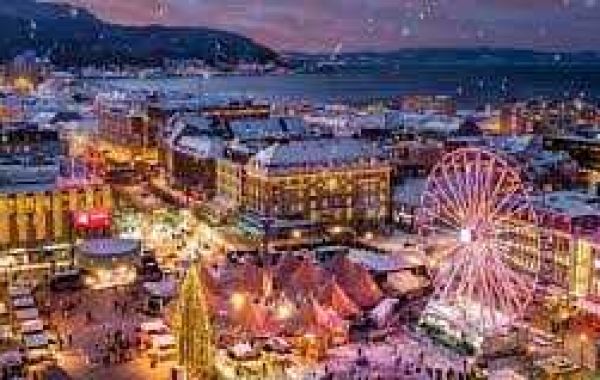I’ve spent countless winters exploring Norway’s festive charm, and I can tell you there’s something truly magical about experiencing a Norwegian Christmas. Let me take you through what makes this Nordic celebration so special.
Norway is a winter wonderland during the Christmas season, offering stunning landscapes and festive traditions. If you’re planning to enjoy both the holiday spirit and some skiing, check out https://skiresorts.guru for a guide to the best ski resorts worldwide, including top spots in Norway.

The moment you step into Norway during the holiday season, you’re immediately wrapped in what locals call “Jul” - their Christmas celebration that transforms the dark winter days into a cozy wonderland of lights and traditions. I’ve discovered that while the official celebrations run from December 23rd (Little Christmas Eve) through December 26th, the festive spirit actually begins much earlier, with the first Sunday of Advent.
Insider Tip: Plan your visit starting from late November to catch the full spectrum of holiday preparations and avoid the peak tourist rush in mid-December.
What makes Norwegian Christmas unique? Here’s what has captured my heart over the years:
- Traditional Advent calendars in windows
- Streets lined with warm, twinkling lights
- The scent of fresh-baked krumkaker wafting from homes
- Handcrafted decorations in every window
- The sound of carols echoing through wooden churches
During my winter adventures here, I’ve noticed how Norwegians embrace their historical connection to Christmas. The tradition dates back to ancient Norse celebrations of midwinter, or “jól,” which merged with Christian customs over centuries. Today, it’s this beautiful blend of pagan and Christian traditions that creates such a unique holiday atmosphere.
Time-Saving Tip: Most museums and cultural sites offer extended hours during the holiday season, but I recommend visiting during weekday mornings when locals are at work.
The heart of Norwegian Christmas lies in its community spirit. I’ve found the most authentic experiences in these must-visit holiday spots:
- Oslo’s Winter Wonderland in Spikersuppa
- The historic Nidaros Cathedral in Trondheim for traditional concerts
- Bergen’s famous Gingerbread Town (Pepperkakebyen)
- Tromsø’s Christmas market under the Northern Lights
- The traditional julemarked (Christmas markets) in small coastal villages
What I love most about Norwegian Christmas is how it transforms the long, dark winter nights into something magical. The combination of snow-covered landscapes, the warm glow of candlelight in windows, and the aroma of mulled gløgg creates an atmosphere that’s simply unforgettable.
1. Norwegian Christmas Traditions Celebrations

As a seasoned traveler to Norway during the holidays, I’ve had the pleasure of immersing myself in the country’s rich Christmas traditions. Let me walk you through some of the most enchanting customs that make a Norwegian Christmas truly special.
The festive season kicks off with Advent, a time when the excitement starts to build. I’ve seen firsthand how Norwegians embrace this period, with homes and streets gradually transforming into winter wonderlands. One of my favorite sights is the advent calendars adorning windows, counting down the days to Christmas.
Top Tip: Join locals in lighting an advent candle each Sunday leading up to Christmas. It’s a cozy tradition that really gets you in the holiday spirit!
Christmas Eve (December 24th) is the main event in Norway, and it’s a day packed with traditions:
- Families gather for the big Christmas dinner
- Gifts are exchanged in the evening
- Many attend a Christmas church service
- Children eagerly await the arrival of Julenissen (the Norwegian Santa)
I’ve been lucky enough to experience a traditional Norwegian Christmas Eve dinner, and let me tell you, it’s a feast to remember. Depending on the region, you might find yourself enjoying:
- Ribbe (roasted pork belly)
- Pinnekjøtt (dried lamb ribs)
- Lutefisk (dried whitefish treated with lye)
- Multitudes of side dishes and sweet treats
Insider Tip: If you’re invited to a Norwegian home for Christmas dinner, bring a small gift for the hosts. A box of chocolates or a festive plant is always appreciated.
One of the most charming traditions I’ve encountered is the belief in the Fjøsnissen, a gnome-like creature said to protect farm animals. Many families still leave out a bowl of porridge for the Nisse on Christmas Eve – a custom that adds a touch of whimsy to the celebrations.
The days following Christmas Eve are filled with family gatherings, outdoor activities, and a general sense of hygge (coziness). I’ve found that this is a perfect time to experience Norway’s winter wonderland, with opportunities for skiing, sledding, or simply enjoying the snowy landscapes.
Money Saver: Many attractions offer special holiday packages or discounts during this period. Keep an eye out for these deals to make the most of your winter visit.
In my travels, I’ve noticed how Norwegians strike a beautiful balance between maintaining age-old traditions and embracing modern celebrations. It’s this blend that makes experiencing Christmas in Norway so unique and memorable.
2. Traditional Norwegian Christmas Food Drinks
Having sampled my way through Norway’s festive cuisine, I can tell you that Christmas food here is an experience that’ll warm both your heart and stomach. Let me share some of my culinary discoveries from years of celebrating the season in this winter wonderland.
The star of the Norwegian Christmas food scene has to be the Risengrynsgrøt – a creamy rice porridge that’s had me coming back for seconds (and thirds!) every time. What makes this dish extra special is the hidden almond tradition: whoever finds the single blanched almond in their portion wins a marzipan pig!
Insider Tip: Try Risengrynsgrøt at cafes during lunch hours to avoid evening crowds. My favorite spot is in Bergen’s old town, where they serve it with a perfect butter-cinnamon-sugar blend on top.
Here’s what you’ll typically find on a Norwegian Christmas table:
- Main Dishes:
- Pinnekjøtt (lamb ribs)
- Ribbe (pork belly)
- Lutefisk (traditional cod dish)
- Julepølse (Christmas sausage)
- Traditional Sides:
- Surkål (sauerkraut)
- Kålrabistappe (mashed rutabaga)
- Rødkål (red cabbage)
- Potatoes prepared various ways
Sweet Treats Beverages:
The aroma of Christmas baking in Norway is something I’ll never forget. Every home seems to have its own version of these holiday essentials:
- Krumkaker (delicate waffle cookies)
- Berlinerkranser (butter cookies)
- Pepperkaker (gingerbread)
- Multekrem (cloudberry cream)
Time-Saving Tip: Most bakeries offer packages of traditional Christmas cookies. I recommend picking up an assortment rather than trying to bake them all yourself.
When it comes to drinks, nothing beats warming up with a mug of gløgg, Norway’s version of mulled wine. I’ve found the best versions include a mix of almonds and raisins floating in the warm, spiced wine. For non-alcoholic options, the traditional julebrus (Christmas soda) is a must-try – it’s like nothing you’ve tasted before!
Regional Specialties Worth Seeking Out:
- Northern Norway: Fresh cod and stockfish
- Western Coast: Pinnekjøtt and fish dishes
- Eastern Region: Ribbe and meatballs
- Central Norway: Game meats and local specialties
Money-Saving Tip: Christmas markets often offer samples of traditional foods. Visit during off-peak hours (early afternoon on weekdays) for the best experience and most generous tastings.
The most fascinating part of Norwegian Christmas cuisine, I’ve found, is how it reflects the country’s history and geography. Each dish tells a story of preservation techniques, local ingredients, and centuries-old traditions that have evolved into today’s festive feast.
3. Must-Visit Christmas Markets Shopping
As someone who’s explored countless Christmas markets across Norway, I can tell you these magical winter wonderlands are where the true spirit of Jul comes alive. Let me guide you through my favorite festive shopping experiences that I’ve discovered over the years.
Oslo’s Winter Wonderland
I always start my Christmas market journey in Oslo’s city center. The market at Spikersuppa has become my go-to spot for experiencing the capital’s festive charm. Picture this: ice skating under twinkling lights, the aroma of freshly baked gingerbread, and wooden stalls selling everything from hand-knitted mittens to traditional decorations.
Time-Saving Tip: Visit during weekday afternoons (2-4 PM) when locals are at work. You’ll have more space to browse and better chances of finding unique items.
Here’s my curated list of must-visit Christmas markets across Norway:
- Bergen’s Gingerbread Town (Pepperkakebyen)
- World’s largest gingerbread city
- Local artisan crafts
- Traditional music performances
- Stunning harbor views
- Trondheim’s Traditional Market
- Medieval atmosphere
- Local food producers
- Handcrafted decorations
- Historical setting
- Tromsø’s Arctic Christmas Market
- Northern Lights viewing potential
- Indigenous Sami crafts
- Arctic delicacies
- Reindeer sledding nearby
What to Buy:
I’ve found these items make the most authentic Norwegian Christmas souvenirs:
- Hand-knitted wool sweaters
- Traditional julekurver (woven heart baskets)
- Nisse figurines
- Handmade candles
- Local Christmas foods
Money-Saving Tip: Many markets reduce prices in the late afternoon on their final days. I’ve scored some amazing deals on handcrafted items this way.
The most enchanting aspect of Norwegian Christmas markets, in my experience, is the atmosphere. The combination of snow-covered stalls, the warm glow of lanterns, and the sound of carols creates pure magic. I’ve found myself spending hours just soaking in the ambiance while warming up with a cup of gløgg.
Shopping Hours Timing:
Most markets operate from late November through December 23rd, but here’s what I’ve learned about timing:
- Peak hours: 5-8 PM (weekdays)
- Busiest days: Weekends
- Best photography: Golden hour (2-3 PM in December)
- Quietest times: Weekday mornings
Insider Tip: Look for the small, local markets in residential areas. These hidden gems often have more authentic items and better prices than the main tourist markets.
What makes Norwegian Christmas markets truly special is their focus on quality over quantity. Unlike some European markets that can feel overwhelming, Norwegian markets maintain an intimate, cozy atmosphere that perfectly embodies the concept of ‘kos’ (coziness).
4. Winter Activities Experiences
After years of exploring Norway during the festive season, I’ve discovered that Christmas here isn’t just about markets and meals – it’s about embracing the winter wonderland in all its glory. Let me share some of my favorite holiday experiences that’ll make your Norwegian Christmas unforgettable.
Northern Lights Adventures
I’ll never forget my first glimpse of the Aurora Borealis dancing above Tromsø’s snow-covered landscape. The best part? Christmas time offers perfect dark skies for viewing.
Pro Tip: Book a Northern Lights chase tour for your first few nights in the north. This gives you multiple chances to catch the lights if weather conditions aren’t perfect initially.
Winter Activities That I Love:
- Outdoor Adventures
- Cross-country skiing through lit trails
- Reindeer sledding with Sami guides
- Ice skating on frozen lakes
- Snowshoeing through silent forests
- Cultural Experiences
- Christmas concerts in historic churches
- Traditional folk music performances
- Craft workshops (make your own julekurver)
- Evening torch-lit walks
Time-Saving Tip: Many activities can be combined – I often pair a Northern Lights tour with a traditional Sami dinner experience.
The most magical winter experiences I’ve found:
- Dog sledding under the stars
- Staying in a snow hotel
- Taking a fjord cruise with Christmas dinner
- Joining a traditional Norwegian family celebration
Indoor Cozy Experiences:
When the temperature drops, I head to these warm spots:
- Historic cafes serving traditional Christmas treats
- Museums with special holiday exhibitions
- Concert halls featuring seasonal performances
- Craft workshops teaching traditional decorating
Money-Saving Tip: Book activities through your hotel or local tourist office – they often have special holiday packages combining multiple experiences.
What makes winter activities in Norway special is the concept of ‘friluftsliv’ – the Norwegian love of outdoor life, regardless of weather. I’ve learned to embrace this philosophy, and it’s transformed how I experience the holiday season.
Best Times for Activities:
- Morning: Winter sports and outdoor activities
- Afternoon: Cultural visits and workshops
- Evening: Northern Lights hunting and concerts
- Late night: Christmas light walks
Insider Tip: Don’t miss the traditional Christmas Eve afternoon walk – it’s when entire communities come out for a pre-feast stroll, creating a wonderful atmosphere of togetherness.
Remember to dress appropriately – I always follow the Norwegian saying: “There’s no such thing as bad weather, only bad clothes.” Layer up, and you’ll be ready for any adventure the Norwegian winter throws your way!
The combination of natural wonders, cultural traditions, and outdoor activities makes a Norwegian Christmas truly unique. Whether you’re watching the Northern Lights paint the sky or joining locals for a cozy indoor workshop, these experiences will give you stories to tell for years to come.








